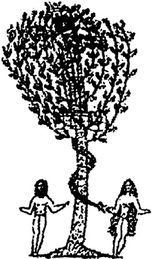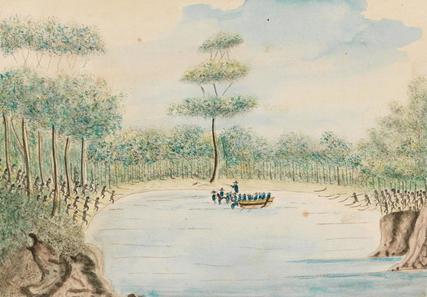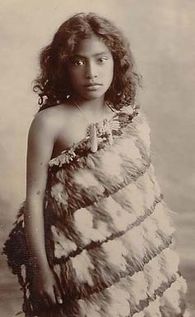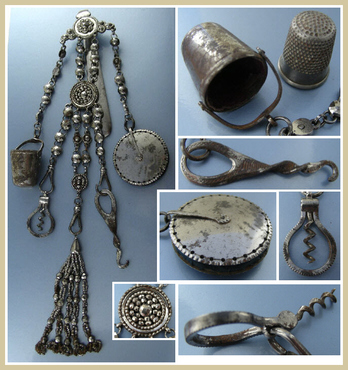Mary: To the ends of the earth....
I was fortunate to write much of The Penny Heart in Australia and New Zealand, as I house-swapped across the Antipodes with my husband, Martin. For a year, we lived on New Zealand's East Cape, and watched the same view of the rolling Pacific studded with volcanoes as that recorded in Captain Cook's Journal. What would life have been like, I wondered, back in the eighteenth century?
 A tattoo of Adam and Eve taken from the skin of a convict
A tattoo of Adam and Eve taken from the skin of a convict
In 1788, just across the Tasman sea the British had set up a penal colony at Sydney Cove, Australia. As a response to prison overcrowding, the first fleet of 11 ships had sailed around the world carrying more than 1,000 convicts, marines and seamen. It was a remarkable experiment; an attempt to transplant the British way of life into a harsh and unknown environment with markedly different weather, flora and fauna.
When we travelled to Australia we found much poignant history about those stranded Britons, most of whom never saw their loved ones again. On visits to early settler homes I was struck by small collections of cherished objects: locks of hair, scraps of fabric, and portrait miniatures. Whenever modern travellers complained about the 24-hour flight from Europe to Australia I couldn't help but remind them that the journey had once involved at least an eight month voyage across wild seas with little chance of ever returning.
When researching recipes of the era I considered the starvation rations that the first settlers attempted to survive upon. The notion of Mary's dark recipe collection of Mother Eve's Secrets grew from real-life accounts of starving prisoners obsessively discussing food and recipes. I included secret ‘remedies’ and elixirs because these were the currency of many criminal quacks and charlatans, used to swindle the public and gain power over the innocent. By the time Mary was transported, she had made a vow to follow what was known as 'The Life'; to live for profit as a criminal, as part of a lively culture that spoke a secret language of cant. As such, she wore tattoo designs recorded on the skins of real convicts, including 'The Serpent Tempted Me and I Did Eat' and a picture of Adam and Eve.
When we travelled to Australia we found much poignant history about those stranded Britons, most of whom never saw their loved ones again. On visits to early settler homes I was struck by small collections of cherished objects: locks of hair, scraps of fabric, and portrait miniatures. Whenever modern travellers complained about the 24-hour flight from Europe to Australia I couldn't help but remind them that the journey had once involved at least an eight month voyage across wild seas with little chance of ever returning.
When researching recipes of the era I considered the starvation rations that the first settlers attempted to survive upon. The notion of Mary's dark recipe collection of Mother Eve's Secrets grew from real-life accounts of starving prisoners obsessively discussing food and recipes. I included secret ‘remedies’ and elixirs because these were the currency of many criminal quacks and charlatans, used to swindle the public and gain power over the innocent. By the time Mary was transported, she had made a vow to follow what was known as 'The Life'; to live for profit as a criminal, as part of a lively culture that spoke a secret language of cant. As such, she wore tattoo designs recorded on the skins of real convicts, including 'The Serpent Tempted Me and I Did Eat' and a picture of Adam and Eve.
Back in eighteenth century New Zealand, the inhabitants were Maori tribal groups, a warrior-like people with rich mythologies and customs, originally from Polynesia. First contact between Maori and the sparse European visitors had very variable outcomes, from friendly trading to violent attacks by both sides. A small number of European women were captured by Maori and these accounts were an influence on The Penny Heart, though interpretations of events are problematic, given that the women themselves gave no first-hand accounts.
Mary's adventures were in part inspired by Mary Bryant (also known as Mary Broad) of Fowey, England, who was also transported on the First Fleet. She survived a series of such extraordinary events that they would have strained credulity in a novel. Mary Bryant was a very different character from Peg and her life can be discovered in an excellent book, To Brave Every Danger: The Epic Life of Mary Bryant of Fowey (Truran, 1993) by Judith Cook, or a less authentic but entertaining film, The Incredible Journey of Mary Bryant (2005).
A potent symbol of Mary's revenge is the housekeeper's chatelaine she wears at her waist, adding keys and implements that hold the power to Delafosse Hall.
A potent symbol of Mary's revenge is the housekeeper's chatelaine she wears at her waist, adding keys and implements that hold the power to Delafosse Hall.


